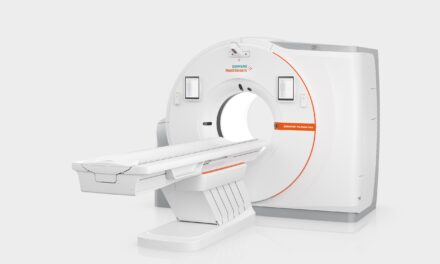GE Healthcare announces that it has received U.S. FDA 510(k) clearance for an artificial intelligence (AI) algorithm to help clinicians assess endotracheal tube (ETT) placements. The AI solution is one of five included in GE Healthcare’s Critical Care Suite 2.0, a collection of AI algorithms embedded on a mobile x-ray device for automated measurements, case prioritization, and quality control.
GE has distributed this solution under the FDA COVID-19 imaging guidance since November 2020, citing its potential to impact clinicians who were experiencing an influx of critically ill COVID-19 patients who required ventilation. Research shows that up to 25% of patients intubated outside of the operating room have misplaced ETTs on chest x-rays, which can lead to severe complications for patients, including hyperinflation, pneumothorax, cardiac arrest, and death.
“At GE Healthcare, we saw the potential role of Critical Care Suite 2.0 in helping hospitals manage the crisis caused by the number of patients who needed ETT placements during the pandemic, requiring accelerated innovation, and we quickly worked with the FDA to make the solution available to clinicians,” says Jan Makela, president and CEO, imaging at GE Healthcare.
“The pandemic has proven what we already knew—that data, AI and connectivity are central to helping front line clinicians deliver intelligently efficient care,” Makela adds. “GE Healthcare is not only accelerating the development and access of new tools to help hospital staff keep up with demand, but also leading the way on COVID-era advancements that will transform the industry and have a long-lasting impact after the pandemic.”
Up to 45% of ICU patients, including severe COVID-19 cases, receive ETT intubation for ventilation. While proper ETT placement can be difficult, Critical Care Suite 2.0 uses AI to automatically detect ETTs in chest x-ray images and provides an accurate and automated measurement of ETT positioning to clinicians within seconds of image acquisition, displaying the results on the monitor of the x-ray system.
The AI generated measurements—along with an image overlay—are then made accessible in PACS. The average error is less than 1.0 mm when calculating the endotracheal tube tip-to-carina vertical distance. With these measurements, clinicians can determine if the ETT is placed correctly or if additional attention is required for proper placement.
Improper positioning of the ETT during intubation can lead to various complications, including a pneumothorax, a type of collapsed lung. While the chest x-ray images of a suspected pneumothorax patient are often marked “STAT,” they can sit waiting for up to eight hours for a radiologist’s review.
However, when a patient is scanned on a device with Critical Care Suite 2.0, the system automatically analyzes images and sends an alert for cases with a suspected pneumothorax—along with the original chest x-ray—to the radiologist for review in PACS. The technologist also receives a subsequent on-device notification to provide awareness of the prioritized cases.
To make the AI suite more accessible, Critical Care Suite 2.0 is embedded on a mobile x-ray device—offering hospitals an opportunity to try AI without making investments into additional IT infrastructure, security assessments. or cybersecurity precautions for routing images offsite.





